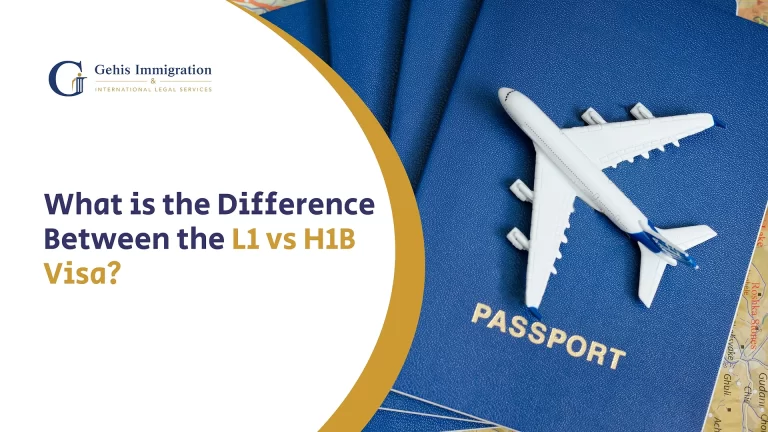Of the many different types of visas, the L1 and H-1B visas are particularly important for people who want to work in the United States. The more we explore the subtleties of these visas, the more important it is to understand their unique features, requirements, and consequences.
This article seeks to clarify the significant differences between H-1B and L-1 visas, providing readers with a thorough grasp of each visa’s distinctive characteristics and a roadmap through its nuances. Before we begin this journey, let’s first review the L1 and H-1B visas, highlighting the importance of understanding their distinctions and the wider scope of this investigation.
About L1 Visa:
The L1 visa, a cornerstone within the framework of U.S. immigration law, serves as a vital conduit for facilitating the seamless transfer of skilled employees within multinational corporations. With its primary aim in fostering the interchange of talent, this visa category enables organisations to strategically deploy key personnel to their U.S. branches, subsidiaries, or affiliates.
At its essence, the L1 visa designates the holder as an intracompany transferee, orchestrating a deliberate movement of individuals possessing specialised knowledge or managerial roles. This strategic deployment, in turn, contributes significantly to the growth and operational efficiency of both the home and U.S. entities.
Distinguishing between the L1A and L1B categories is crucial, as the former caters to executives or managers, emphasising leadership roles, while the latter is tailored for employees with specialised knowledge, accentuating their unique expertise within the organisational framework.
Meeting specific eligibility criteria is pivotal, with a qualifying relationship between overseas and U.S. entities as a linchpin for approval. This relationship, often demonstrated through parent-subsidiary, branch office, or affiliate connections, underscores the necessity of a genuine multinational presence.
L1 visa eligibility further depends on the employee’s qualifications and role within the company, with managerial or executive responsibilities being vital for L1A and a showcase of specialised knowledge integral to the organisation for L1B.
Understanding the advantages and limitations of the L1 visa is crucial for informed decision-making, with its unique feature of dual intent allowing for potential future green card applications. Restrictions on self-employment and specific job roles are important .
The allowance of dual intent is a distinctive feature, permitting L1 visa holders to pursue permanent residency while maintaining L1 status, aligning personal and professional aspirations seamlessly. The L1 visa extends its benefits to spouses through employment authorisation, fostering a holistic support system for relocating families.
While L1 visas are initially granted for a specific duration, extensions are feasible, particularly for those under the L1A category, recognising the sustained need for managerial or executive contributions.
An L1 visa journey necessitates a comprehensive understanding of these intricacies, ensuring a smooth transition for both the employee and the organisation, laying the groundwork for successful intracompany transfers.
About H1-B
The H-1B visa, integral to the fabric of U.S. immigration, is a gateway for foreign nationals possessing specialised skills to make impactful contributions to the American workforce. Made for individuals engaged in speciality occupations, this visa is a key to opportunities for talented professionals worldwide.
The H-1B visa is dedicated to those requiring a high level of specialised knowledge, often acquired through advanced education or extensive experience, ensuring that visa holders bring unique expertise to roles demanding specialised skills.
As an employer-sponsored visa, the H-1B mandates U.S. employers to sponsor applicants, underscoring their commitment to leveraging the specialised skills of prospective employees for the benefit of the American workforce.
Individuals must meet specific eligibility criteria to qualify, demonstrating the requisite education and skills for their specialty occupation and securing sponsorship from a U.S. employer.
The applicant’s educational background is central to H-1B eligibility, often requiring a bachelor’s degree or higher or equivalent work experience to showcase proficiency in the designated field. U.S. employers undertaking H-1B sponsorship commit to specific obligations, including paying prevailing wages, providing suitable working conditions, and adhering to the terms outlined in the Labor Condition Application (LCA).
Understanding the advantages and limitations of the H-1B visa is pivotal, considering factors such as the annual quota and specific employment constraints. Operating under an annual numerical cap, the H-1B visa introduces quota limitations that impact visa availability, necessitating prospective applicants to be mindful of potential competition for the available slots.
The H-1B visa allows for dual intent, enabling visa holders to pursue permanent residency while maintaining their H-1B status, aligning with the long-term aspirations of skilled professionals.
H-1B visa holders can bring their spouses and dependent children to the U.S. under the H-4 visa category, fostering family unity during employment.
The H-1B visa journey demands an understanding of these intricacies, ensuring that skilled professionals and their sponsoring employers complete the process with clarity and confidence, ultimately contributing to the vibrancy and diversity of the U.S. workforce.
Key Differences Between L1 and H-1B Visas.
- One of the fundamental distinctions lies in the purpose and nature of employment for L1 and H-1B visas. The L1 visa is designed for intracompany transfers, facilitating the movement of employees within multinational organisations. On the other hand, the H-1B visa caters to individuals with specialised skills contributing to U.S. businesses in speciality occupations.
- The eligibility criteria for employers and employees vary significantly between the L1 and H-1B visas. L1 eligibility requires a qualifying relationship between the overseas and U.S. entities, emphasising a multinational presence. In contrast, H-1B eligibility demands U.S. employers to sponsor applicants with specialised skills, meeting specific educational and occupational requirements.
- Dual intent, the ability to pursue permanent residency while holding a non-immigrant visa, is a critical differentiator. L1 visa holders can maintain dual intent, allowing for potential green card applications. H-1B visa holders can also pursue permanent residency, seamlessly aligning personal and professional aspirations.
- Considerations for spouses and dependents diverge between L1 and H-1B visas. L1 visa holders can extend benefits to their spouses through employment authorisation, fostering a comprehensive support system for relocating families. H-1B visa holders can bring their spouses and dependents to the U.S. under the H-4 visa category, ensuring family unity during employment.
- Quota limitations and processing times constitute substantial divergences between L1 and H-1B visas. The H-1B visa operates under an annual numerical cap, introducing quota limitations that can impact visa availability. L1 visas do not face such numerical constraints. Processing times for both visas can vary, influenced by demand, administrative workload, and specific immigration policies.
The future outlook of L1 and H-1B visas is subject to the dynamic landscape of U.S. immigration policies. As geopolitical, economic, and societal factors evolve, potential visa regulation developments may emerge. Anticipating and adapting to these changes will be essential for employers and individuals in the ever-shifting terrain of immigration.
As the global workforce becomes increasingly interconnected, the choices between L1 and H-1B visas carry profound implications. Whether fostering the exchange of talent within multinational corporations or addressing the demand for specialised skills in the U.S., these visas play instrumental roles in shaping the diversity and dynamism of the American workforce. By staying informed, considering individual circumstances, and adapting to the evolving immigration , employers and individuals can walk these visa pathways with clarity and confidence, contributing to a vibrant and resilient U.S. economy.





